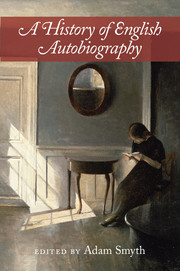Book contents
- Frontmatter
- Dedication
- Contents
- List of contributors
- 1 Introduction: The range, limits, and potentials of the form
- PART 1 AUTOBIOGRAPHY BEFORE ‘AUTOBIOGRAPHY’ (CA. 1300–1700)
- PART 2 RELIGION, GENDER, THINGS (CA. 1700–1800)
- PART 3 THE MANY NINETEENTH CENTURIES (CA. 1800–1900)
- 12 Working-class autobiography in the nineteenth century
- 13 Romantic life-writing
- 14 Nineteenth-century spiritual autobiography: Carlyle, Newman, Mill
- 15 Emerging selves: The autobiographical impulse in Elizabeth Barrett Browning, Anne Thackeray Ritchie, and Annie Wood Besant
- 16 Victorian artists’ autobiographies: Transgression, res gestae, and the collective life
- 17 Victorian print culture: Periodicals and serial lives, 1830–1860
- PART 4 RELATIONAL LIVES AND FORMS OF REMEMBERING (CA. 1890–1930)
- PART 5 KINDS OF COMMUNITY (CA. 1930-CONTEMPORARY)
- Index
- References
13 - Romantic life-writing
from PART 3 - THE MANY NINETEENTH CENTURIES (CA. 1800–1900)
Published online by Cambridge University Press: 05 March 2016
- Frontmatter
- Dedication
- Contents
- List of contributors
- 1 Introduction: The range, limits, and potentials of the form
- PART 1 AUTOBIOGRAPHY BEFORE ‘AUTOBIOGRAPHY’ (CA. 1300–1700)
- PART 2 RELIGION, GENDER, THINGS (CA. 1700–1800)
- PART 3 THE MANY NINETEENTH CENTURIES (CA. 1800–1900)
- 12 Working-class autobiography in the nineteenth century
- 13 Romantic life-writing
- 14 Nineteenth-century spiritual autobiography: Carlyle, Newman, Mill
- 15 Emerging selves: The autobiographical impulse in Elizabeth Barrett Browning, Anne Thackeray Ritchie, and Annie Wood Besant
- 16 Victorian artists’ autobiographies: Transgression, res gestae, and the collective life
- 17 Victorian print culture: Periodicals and serial lives, 1830–1860
- PART 4 RELATIONAL LIVES AND FORMS OF REMEMBERING (CA. 1890–1930)
- PART 5 KINDS OF COMMUNITY (CA. 1930-CONTEMPORARY)
- Index
- References
Summary
Autobiography came of age in the Romantic period. The term was coined at that time: according to the Oxford English Dictionary it was used by William Taylor in 1797 as an alternative to ‘self-biography’, ‘confessions’, and ‘memoirs’. This essay explains why the form came to prominence, examines the manner in which some of the finest writers of the time approached it, and offers some notion of how Romantic autobiography differed from that in subsequent decades. I have been guided by Adam Smyth's suggestion that an influential conception of autobiography would be ‘a narrative that is retrospective, chronological, whose central theme is the development of the author's personality’ (Smyth 2010, 13).
The emergence of autobiography into the literary mainstream may be explained by a single name: Jean-Jacques Rousseau. Sometimes described as the first Romantic, he completed his Confessions in December 1770, the year of Wordsworth's birth. It confronted readers with such topics as an account of his mistress, Madame de Warens (O'Rourke 2006, ch. 1). In Britain it was improper to speak of such matters in print, whatever was thought acceptable in France. Almost as bad was to suppose such things would interest readers, as contemporaries did not hesitate to point out:
This was the man whose vanity and presumption so imposed on his understanding, as to lead him to imagine that mankind would lend a ready ear to the most trifling, to the most dull, to the most impertinent, to the most disgusting relations, because they concerned rousseau! (Monthly Review 1783, 150)
These arguments were crucial to the reputation not only of Rousseau but of autobiographical discourse of any kind, and for decades the form was thought to harbour indecency and immorality, the resort of shameless egotists (Treadwell 2005, chs. 1 and 2). Rousseau's Confessions elicited critical disapproval, but proved popular with readers, sparking a bidding war even before its first appearance on the Continent, and selling in large quantities after British publication in 1783. The critical response continued for years, often in the form of ad hominem attacks on Rousseau himself, and for that reason the reputation of the Confessions ‘overshadowed’ the period (Ibid., 41), raising anxieties about the propriety of autobiography as a form.
- Type
- Chapter
- Information
- A History of English Autobiography , pp. 179 - 191Publisher: Cambridge University PressPrint publication year: 2016



